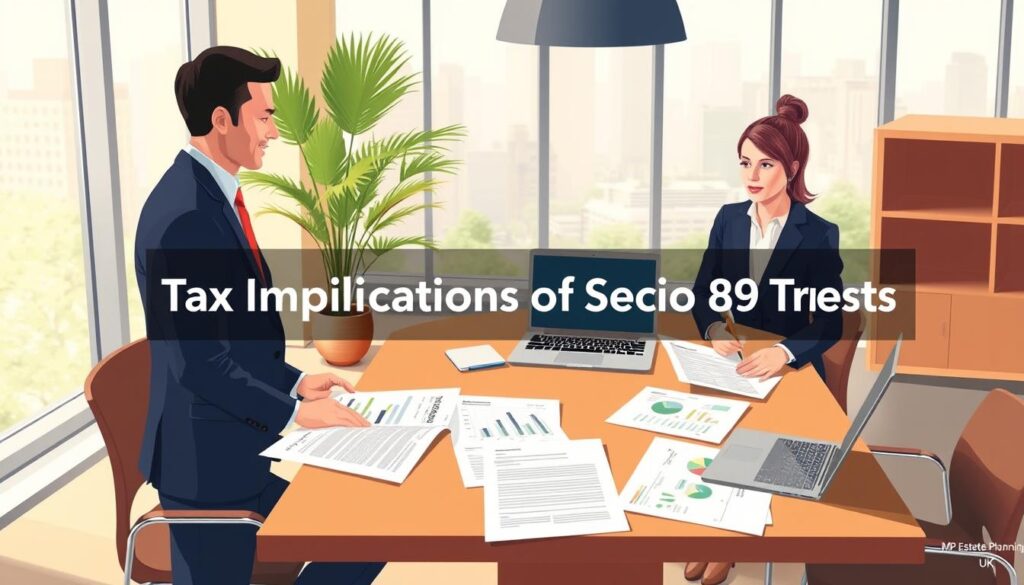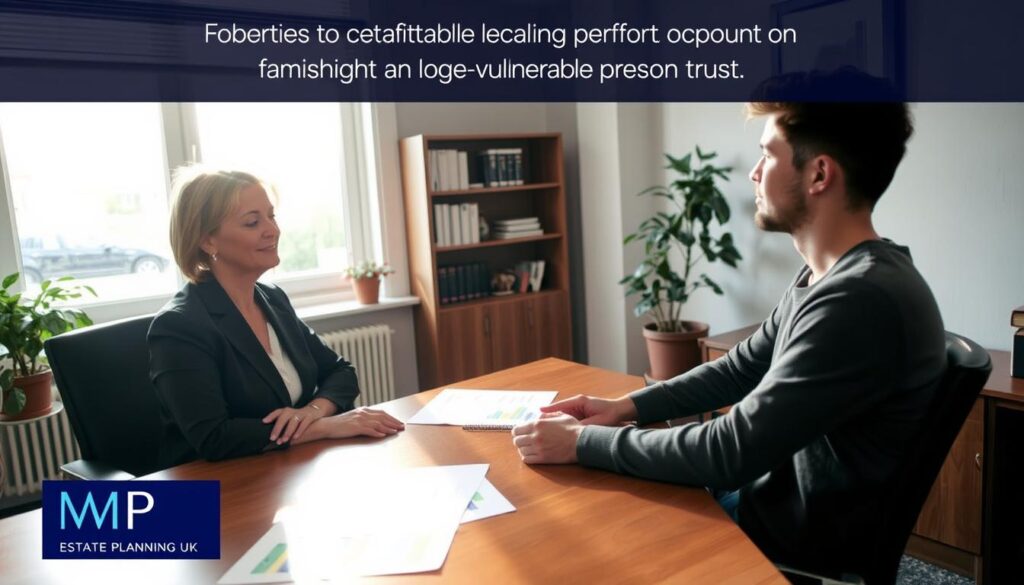Did you know that thousands of families in the UK could be missing out on crucial tax benefits by not utilising Vulnerable Person Trusts? These trusts are designed to support vulnerable beneficiaries, including disabled individuals and bereaved minors, by providing a safeguard for their financial well-being.
We understand the importance of securing your family’s future through effective estate planning. A Vulnerable Person Trust can offer special tax treatment, but it’s essential to understand the qualifying criteria and tax rules applicable in the UK.
At present, trusts for vulnerable beneficiaries can benefit from favourable tax treatment, but the rules can be complex. We will guide you through the process, ensuring you make informed decisions about your family’s financial security.
Key Takeaways
- Understand the qualifying criteria for Vulnerable Person Trusts.
- Learn about the special tax treatment available for these trusts.
- Discover how to secure your family’s financial future.
- Find out how to claim special tax treatment for Income Tax and Capital Gains Tax.
- Understand the role of the Mental Capacity Act in safeguarding vulnerable adults.
Understanding Vulnerable Person Trusts: An Overview
For families navigating the complexities of caring for a disabled person or a bereaved minor, Vulnerable Person Trusts offer a protective solution. These trusts are designed to provide financial security and protection for vulnerable individuals, ensuring their needs are met without jeopardizing their eligibility for state benefits.
What is a Vulnerable Person Trust?
A Vulnerable Person Trust is established either for a disabled person or a bereaved minor, providing them with financial support while protecting their interests. Special tax treatment applies to these trusts, making them an attractive option for families seeking to minimize tax liabilities.
The trust is typically set up by a parent or guardian who wants to ensure the long-term financial well-being of their loved one. By doing so, they can have peace of mind knowing that the trust assets are managed in the best interests of the beneficiary.
Key Features of Vulnerable Person Trusts
Vulnerable Person Trusts have several key features that make them beneficial for vulnerable beneficiaries. These include:
- Tax Benefits: Eligible for special tax treatment, which can reduce the tax burden on the trust.
- Protection of Assets: Assets placed in the trust are managed for the benefit of the vulnerable individual, protecting them from misuse.
- Flexibility: Trusts can be tailored to meet the specific needs of the beneficiary, providing flexibility in how assets are used.
When setting up a Vulnerable Person Trust, it’s essential to consider the Best Interests Decision Making process to ensure that the trust is established in a way that prioritizes the beneficiary’s needs. This involves careful planning and consideration of the beneficiary’s current and future needs.
| Feature | Description | Benefit |
|---|---|---|
| Special Tax Treatment | Eligible for reduced tax rates | Minimizes tax liability, maximizing trust assets |
| Asset Protection | Assets managed for the beneficiary’s benefit | Ensures assets are used in the best interests of the vulnerable individual |
| Flexibility | Trusts can be tailored to meet specific needs | Provides adaptability in managing the trust assets |
For more detailed information on Vulnerable Person Trusts, including the relevant legislation and guidelines, you can refer to the UK Government’s publication on Vulnerable Beneficiary.
The Legal Framework of Section 89 Trusts
The legal framework governing Section 89 Trusts is multifaceted, involving various legislation and regulatory bodies. Understanding this framework is crucial for the effective establishment and management of these trusts.
Relevant Legislation and Guidelines
Section 89 Trusts are primarily governed by several key pieces of legislation, including the Inheritance Tax Act 1984 and the Taxation of Chargeable Gains Act 1992. These acts provide the foundation for how these trusts are treated for tax purposes.
Additionally, the Care Act 2014 and the Mental Health Act 1983 play significant roles in defining the context in which these trusts operate, particularly in relation to the care and support of vulnerable individuals.
- The Inheritance Tax Act 1984 outlines the tax relief available to vulnerable person trusts.
- The Taxation of Chargeable Gains Act 1992 details how capital gains are treated for these trusts.
- The Care Act 2014 provides guidance on the care and support needs of vulnerable adults.
- The Mental Health Act 1983 is crucial for understanding the legal context of mental health care.

Who Governs These Trusts?
The governance of Section 89 Trusts involves several regulatory bodies and professional organizations. The Care Quality Commission (CQC) provides guidance on the quality of care services, which is particularly relevant for trusts involved in caring for vulnerable individuals.
Trustees are also expected to comply with the regulations set out by HMRC and other relevant bodies to ensure that the trust is administered correctly and in accordance with the law.
- HMRC oversees the tax compliance of Section 89 Trusts.
- The Care Quality Commission regulates care services provided by or through these trusts.
- Professional bodies, such as the Law Society, provide guidance on best practices for trustees.
Eligibility Criteria for Vulnerable Person Trusts
The eligibility criteria for Vulnerable Person Trusts are specific and centered around the definition of a vulnerable beneficiary. To qualify, the beneficiary must meet certain conditions that are primarily related to their age, disability, or circumstances.
Definition of a Vulnerable Beneficiary
A vulnerable beneficiary is typically defined as either a disabled person or a bereaved minor under the age of 18. Disabled persons are those who are entitled to certain benefits due to their condition, while bereaved minors are children who have lost one or both parents.
To be considered disabled, an individual must be receiving specific disability benefits, such as Disability Living Allowance or Personal Independence Payment. For bereaved minors, the condition is met if they are under 18 and have lost a parent.
Income and Capital Considerations
When assessing eligibility, the income and capital of the vulnerable beneficiary are crucial factors. The trust’s income and capital must be managed in a way that benefits the vulnerable individual without jeopardizing their eligibility for state benefits.
The trust’s assets and income are considered when determining the beneficiary’s entitlement to means-tested benefits. It is essential to ensure that the trust is structured in a way that maximizes the beneficiary’s financial situation without adversely affecting their state support.
Key considerations include:
- The source and amount of income received by the trust.
- The capital assets held within the trust and their value.
- How the trust’s income and capital are utilized for the beneficiary’s benefit.
By carefully managing these factors, we can ensure that the Vulnerable Person Trust is effective in safeguarding the vulnerable adult or child, providing them with the necessary financial support and protection.
Tax Implications of Section 89 Trusts
Section 89 Trusts offer special tax treatment that can significantly reduce the tax burden on vulnerable beneficiaries. This special treatment is a crucial aspect to consider when evaluating the overall benefits of establishing such a trust.

Overview of Inheritance Tax Rules
Inheritance Tax (IHT) is a significant consideration for trusts. Section 89 Trusts are treated as if the trust assets are owned by the vulnerable beneficiary for IHT purposes. This means that the trust assets are not subject to IHT charges that typically apply to trusts, such as the periodic charge and the exit charge, provided certain conditions are met.
To qualify for this favorable IHT treatment, the trust must be established for a vulnerable person, and the trustees must make a claim for special tax treatment. We will outline the key conditions and benefits in the following sections.
Income Tax Regulations for Trusts
Income Tax is another critical aspect of the tax implications for Section 89 Trusts. Normally, trusts are subject to Income Tax on their income, with the trustees being responsible for reporting and paying the tax due. However, for Section 89 Trusts, the Income Tax liability is calculated as if the income were that of the vulnerable beneficiary.
This can result in a reduced Income Tax rate, especially if the beneficiary is a non-taxpayer or has a lower Income Tax rate. The trustees must claim this special treatment, and the beneficiary must be eligible under the relevant legislation.
Key benefits of the special tax treatment for Section 89 Trusts include:
- Relief from Inheritance Tax charges that typically apply to trusts.
- Reduced Income Tax rates, as the tax is calculated based on the beneficiary’s tax position.
By understanding and leveraging these tax benefits, individuals can better protect the assets of vulnerable beneficiaries, ensuring they receive the maximum benefit from the trust.
Benefits of Setting Up a Vulnerable Person Trust
By setting up a Vulnerable Person Trust, families can ensure that their loved ones are protected and provided for in the long term. This type of trust is designed to safeguard the financial future of vulnerable individuals, offering a range of benefits that can significantly impact their quality of life.
Protecting Assets and Income
One of the primary benefits of a Vulnerable Person Trust is its ability to protect assets and income for the beneficiary. By placing assets in trust, families can ensure that these resources are used in the best interests of the vulnerable individual, rather than being vulnerable to external claims or mismanagement.
As noted by a leading expert in trust law, “A well-established Vulnerable Person Trust can provide a safeguard against financial exploitation and ensure that the beneficiary’s needs are met.”
“The key to a successful trust is not just in its establishment, but in its ongoing management and administration.”
Enhancing Financial Security
Enhancing financial security is another significant advantage of setting up a Vulnerable Person Trust. By providing a structured approach to managing the beneficiary’s finances, these trusts can help ensure that their financial needs are met, both now and in the future.
| Benefit | Description |
|---|---|
| Asset Protection | Assets are safeguarded against external claims and mismanagement. |
| Financial Security | A structured approach to managing the beneficiary’s finances. |
| Best Interests Decision Making | Decisions are made in the best interests of the vulnerable beneficiary. |
We understand that every family’s situation is unique, and the specific benefits of a Vulnerable Person Trust will depend on individual circumstances. However, by establishing such a trust, families can take a proactive step towards securing the financial future of their vulnerable loved ones.

Drawbacks to Consider with Section 89 Trusts
While Vulnerable Person Trusts offer numerous benefits, there are also significant drawbacks to consider. Establishing a trust can involve legal complexities and costs, which we will explore in this section.
Potential Legal Complications
One of the primary concerns when setting up a Section 89 Trust is navigating the legal framework. The Care Act 2014 and Mental Health Act 1983 are crucial pieces of legislation that can impact the establishment and management of these trusts.
Legal complications can arise from:
- Ensuring compliance with the relevant laws and regulations.
- Managing the trust in accordance with the beneficiary’s needs and the trust’s objectives.
- Dealing with potential disputes among beneficiaries or between beneficiaries and trustees.
For instance, the disadvantages of UK asset protection trusts can also be relevant when considering Vulnerable Person Trusts, as both involve complex legal and financial decisions.
Costs Associated with Establishing a Trust
The costs of setting up a Vulnerable Person Trust can be significant. These include:
| Cost Component | Description | Estimated Cost |
|---|---|---|
| Legal Fees | Fees for drafting the trust deed and other legal documents. | £1,000 – £3,000 |
| Trustee Fees | Fees for the services of the trustee(s) managing the trust. | £500 – £2,000 per annum |
| Administrative Costs | Costs associated with the day-to-day management of the trust. | £500 – £1,500 per annum |
It’s essential to consider these costs when deciding whether to establish a Section 89 Trust. We recommend consulting with a financial advisor to get a detailed breakdown of the costs involved.

By understanding the potential drawbacks, including legal complications and costs, you can make a more informed decision about whether a Vulnerable Person Trust is right for your situation.
How to Set Up a Vulnerable Person Trust
To create a Vulnerable Person Trust, one must navigate through a series of legal and financial requirements. This process, while complex, is crucial for ensuring that the trust is established correctly and operates effectively to benefit the vulnerable individual.

Step-by-Step Guide to Establishment
Establishing a Vulnerable Person Trust involves several key steps:
- Define the Trust’s Purpose: Clearly outline the reasons for setting up the trust and the benefits it is intended to provide to the vulnerable beneficiary.
- Choose the Beneficiary: Identify the individual who will benefit from the trust, ensuring they meet the criteria for being considered vulnerable.
- Draft the Trust Deed: This legal document outlines the terms of the trust, including the powers of the trustees, the beneficiary’s rights, and how the trust assets are to be managed.
- Select the Trust Assets: Determine what assets will be placed into the trust, which could include cash, property, or investments.
- Register the Trust: Depending on the type of trust and its assets, registration with the appropriate authorities, such as HMRC, may be required.
Choosing the Right Trustee
Selecting a suitable trustee is a critical decision, as this individual or entity will be responsible for managing the trust in accordance with its terms and for the benefit of the vulnerable beneficiary. When choosing a trustee, consider their:
- Trustworthiness: The trustee must act in the best interests of the beneficiary.
- Financial Acumen: They should have the ability to manage the trust assets effectively.
- Understanding of the Beneficiary’s Needs: A good trustee will be aware of the beneficiary’s situation and needs, ensuring that the trust is managed accordingly.
By carefully following these steps and selecting an appropriate trustee, you can establish a Vulnerable Person Trust that provides significant benefits under the UK’s tax rules, particularly under Section 89 of the Inheritance Tax Act 1984.
Key Responsibilities of Trustees
The role of a trustee in a Vulnerable Person Trust is multifaceted and demanding. Trustees are tasked with the duty of safeguarding the trust’s assets and ensuring that the beneficiary’s needs are met in accordance with the trust’s objectives.
Trustees have fiduciary duties, meaning they must act in the best interests of the beneficiary. This includes managing the trust assets prudently and making informed decisions regarding investments and distributions.
Duties of a Trustee in Managing the Trust
A trustee’s duties encompass a range of responsibilities, including:
- Managing the trust’s assets in a way that benefits the vulnerable beneficiary.
- Ensuring compliance with the Mental Capacity Act and other relevant legislation.
- Making decisions that are in the best interest of the beneficiary, taking into account their current needs and circumstances.
Trustees must also be aware of their obligations under the safeguarding vulnerable adults guidelines, ensuring that the beneficiary is protected from harm or exploitation.

Reporting Requirements and Compliance
Trustees are required to comply with various reporting requirements, including:
- Submitting annual tax returns to HMRC.
- Maintaining accurate records of the trust’s income, expenses, and distributions.
- Providing regular updates to the beneficiary or their representatives.
Ensuring compliance with these requirements is crucial to avoid any potential penalties or legal issues. Trustees must stay informed about changes in legislation and regulatory requirements that may affect the trust.
Frequently Asked Questions about Vulnerable Person Trusts
As we journey through the complexities of Vulnerable Person Trusts, we often encounter questions that can significantly impact the establishment and management of these trusts. In this section, we will address some of the most frequently asked questions to provide clarity and guidance.
What Happens If the Beneficiary’s Situation Changes?
A change in the beneficiary’s situation can have significant implications for the trust, particularly in terms of tax treatment. For instance, if a beneficiary ceases to be considered vulnerable, the trust may no longer qualify for the beneficial tax treatment under Section 89. We must monitor the beneficiary’s status and adjust the trust accordingly to ensure compliance with current regulations.
It’s also crucial to consider the impact of changes in the beneficiary’s situation on the deprivation of liberty safeguards. This is especially relevant if the beneficiary is in a care home or receiving other forms of support. Understanding these implications can help trustees make informed decisions.
| Beneficiary’s Status | Tax Implications | Trust Adjustments |
|---|---|---|
| Remains Vulnerable | Continues to benefit from Section 89 tax treatment | No changes needed |
| Ceases to be Vulnerable | Loses beneficial tax treatment under Section 89 | Review and adjust trust provisions |
Can the Trust Be Altered Once Established?
Yes, a Vulnerable Person Trust can be altered after establishment, but this must be done carefully to comply with legal and tax regulations. Any changes should be made with the guidance of legal professionals to ensure that the trust remains compliant and continues to meet its intended purpose.
Alterations may be necessary due to changes in the beneficiary’s circumstances or updates to the adult safeguarding policy. Trustees must be proactive in reviewing the trust and making necessary adjustments.
We understand that managing a Vulnerable Person Trust involves navigating complex legal and tax landscapes. By addressing these frequently asked questions, we hope to provide clarity and support for trustees and beneficiaries alike.
Case Studies: Real-Life Examples of Vulnerable Person Trusts
Real-life examples illustrate the effectiveness of Vulnerable Person Trusts in managing assets for vulnerable individuals. Through case studies, we can see the positive impact these trusts have on the lives of beneficiaries, ensuring their financial security and well-being.
Successful Trust Management Stories
One notable case involved a family setting up a Vulnerable Person Trust for their son, who had significant disabilities. By doing so, they were able to secure his financial future without jeopardizing his eligibility for state benefits. The trust was managed by professional trustees who made Best Interests Decisions in accordance with the Care Act 2014, ensuring the beneficiary received the care and support he needed.
Another success story involved a trust established for an elderly person suffering from dementia. The trustees worked closely with care providers to ensure the beneficiary’s needs were met, using the trust funds to enhance their quality of life. This case highlighted the importance of flexible trust management in responding to changing circumstances.
Lessons Learned from Failed Trusts
Not all Vulnerable Person Trusts have been successful. One case study revealed that poor trustee decisions and inadequate monitoring led to a trust being mismanaged, resulting in financial losses and stress for the beneficiary. This highlights the critical importance of choosing trustworthy and competent trustees.
Another case involved a trust that was not properly aligned with the beneficiary’s needs, leading to inefficiencies in fund allocation. This example underscores the need for careful planning and regular review of the trust’s terms to ensure they remain appropriate.
By examining both successful and less successful cases, we can better understand the factors that contribute to effective trust management. This includes the importance of Best Interests Decision Making and adherence to relevant legislation such as the Care Act 2014.
Future of Vulnerable Person Trusts in the UK
The future of Vulnerable Person Trusts in the UK is closely tied to changes in legislation and trust management practices. As we navigate the complexities of trust law, it’s essential to consider the potential developments that could impact these trusts.
Legislative Changes Ahead
Potential legislative changes are on the horizon, which could significantly affect Vulnerable Person Trusts. For instance, updates to the Mental Health Act 1983 could redefine what it means to be a vulnerable beneficiary, thereby influencing who qualifies for these trusts. We must stay informed about these changes to ensure compliance and optimal trust management.
One key area of focus is the Care Quality Commission guidance, which plays a crucial role in shaping the care and support provided to vulnerable individuals. Any changes to this guidance could have a ripple effect on how trusts are administered.
Key Legislative Changes to Watch:
- Revisions to the Mental Health Act 1983
- Updates to the Care Quality Commission guidance
- Changes in inheritance tax rules
Trends in Trust Management and Use
Trust management is evolving, driven by technological advancements and changing societal needs. Digital tools are becoming increasingly important for managing trusts efficiently, ensuring transparency, and improving beneficiary outcomes.
We are also seeing a trend towards more personalized trust arrangements, tailored to the specific needs of beneficiaries. This includes incorporating flexible provisions for distributions and support, reflecting the diverse circumstances of vulnerable individuals.
| Trend | Description | Impact on Vulnerable Person Trusts |
|---|---|---|
| Digitalization | Increased use of digital tools for trust management | Enhanced transparency and efficiency |
| Personalization | Tailored trust arrangements for beneficiaries | More effective support for vulnerable individuals |
| Regulatory Compliance | Adherence to evolving legislative requirements | Reduced risk of non-compliance |
As we move forward, it’s crucial for professionals and individuals involved with Vulnerable Person Trusts to stay abreast of these changes and trends. By doing so, we can ensure that these trusts continue to provide the necessary protection and support for vulnerable beneficiaries.
Resources for Further Information and Support
For those seeking more information on Vulnerable Person Trusts, various resources are available to provide guidance and support. Understanding the intricacies of these trusts is crucial for safeguarding vulnerable adults and ensuring compliance with UK regulations.
Professional Guidance
Professional bodies and associations, such as the Society of Trust and Estate Practitioners (STEP), offer expert advice on establishing and managing Vulnerable Person Trusts under Section 89. Their resources can be invaluable in navigating the complexities of trust management.
For more detailed information on registering a trust, you can visit MP Estate Planning, which provides expert advice tailored to UK families.
Online Tools and Resources
Several online resources and tools are available to help individuals understand and manage Vulnerable Person Trusts s89 UK. These include government websites, legal databases, and professional networks focused on safeguarding vulnerable adults.
By leveraging these resources, individuals can make informed decisions about setting up and managing a Vulnerable Person Trust, ensuring the financial security and well-being of their loved ones.


